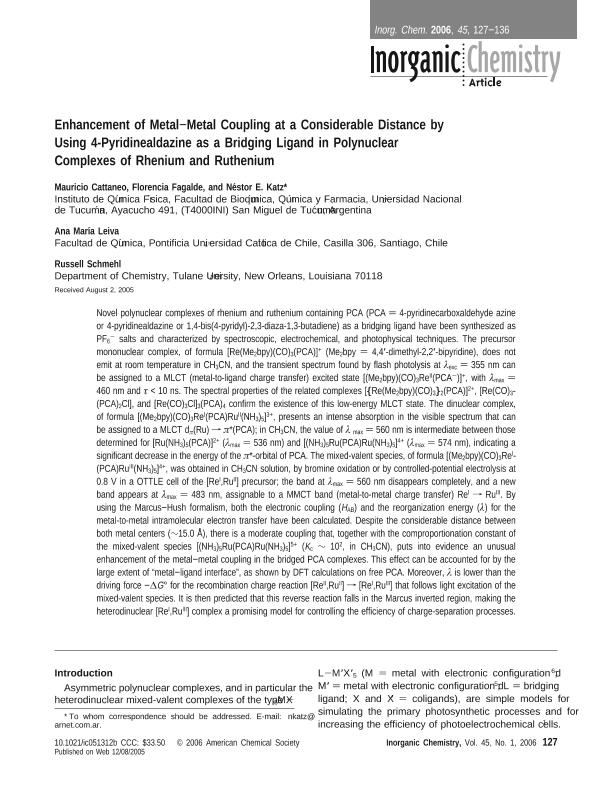Artículo
Enhancement of Metal-Metal Coupling at a Considerable Distance by Using 4-Pyridinealdazine as a Bridging Ligand in Polynuclear Complexes of Rhenium and Ruthenium
Fecha de publicación:
07/2006
Editorial:
American Chemical Society
Revista:
Inorganic Chemistry
ISSN:
0020-1669
Idioma:
Inglés
Tipo de recurso:
Artículo publicado
Clasificación temática:
Resumen
Novel polynuclear complexes of rhenium and ruthenium containing PCA (PCA = 4-pyridinecarboxaldehyde azine or 4-pyridinealdazine or 1,4-bis(4-pyridil)-2,3-diaza-1,3-butadiene) as a bridging ligand have been synthesized as PF6- salts and characterized by spectroscopic, electrochemical and photophysical techniques. The precursor mononuclear complex, of formula [Re(Me2bpy)(CO)3(PCA)]+, (Me2bpy = 4,4´-dimethyl-2,2´-bipyridine), does not emit at room temperature in CH3CN and the transient spectrum found by flash photolysis at lexc = 355 nm can be assigned to a MLCT (metal-to-ligand charge transfer) excited state [(Me2bpy)(CO)3ReII(PCA-)]+, with lmax = 460 nm and t < 10 ns. The spectral properties of the related complexes [{Re(Me2bpy)(CO)3}2(PCA)]2+, [Re(CO)3(PCA)2Cl] and [Re(CO)3Cl]3(PCA)4 confirm the existence of this low-energy MLCT state. The dinuclear complex, of formula [(Me2bpy)(CO)3ReI(PCA)RuII(NH3)5]3+, presents an intense absorption in the visible spectrum that can be assigned to a MLCT dp(Ru) ® p*(PCA); in CH3CN, the value of l max = 560 nm is intermediate between those determined for [Ru(NH3)5(PCA)]2+ (lmax = 536 nm) and [(NH3)5Ru(PCA)Ru(NH3)5]4+ (lmax = 574 nm), indicating a significant decrease in the energy of the p*-orbital of PCA. The mixed valent species, of formula [(Me2bpy)(CO)3ReI(PCA)RuIII(NH3)5]4+, was obtained in CH3CN solution, by bromine oxidation or by controlled potential electrolysis at 0.8 V in a OTTLE cell of the [ReI,RuII] precursor ; the band at lmax = 560 nm disappears completely and a new band appears at lmax = 483 nm , assignable to a MMCT band (metal-to-metal charge transfer) ReI ® RuIII. By using the Marcus-Hush formalism, both the electronic coupling (HAB) and the reorganization energy (l) for the metal-to-metal intramolecular electron transfer have been calculated. In spite of the considerable distance between both metal centers (~ 15.0 Å), there is a moderate coupling that, together with the comproportionation constant of the mixed-valent species [(NH3)5Ru(PCA)Ru(NH3)5]5+ (Kc ~ 102, in CH3CN), put into evidence an unusual enhancement of the metal-metal coupling in the bridged PCA complexes. This effect can be accounted for by the large extent of ?metal-ligand interface?, as shown by DFT calculations on free PCA . Moreover, l is lower than the driving force -DG° for the recombination charge reaction [ReII, RuII ] ® [ReI, RuIII] that follows light excitation of the mixed valent species. It is then predicted that this reverse reaction falls in the Marcus inverted region, making the heterodinuclear [ReI,RuIII] complex a promising model for controlling the efficiency of charge-separation processes.
Palabras clave:
pca
,
mixed valent compound
,
rhenium
Archivos asociados
Licencia
Identificadores
Colecciones
Articulos(CCT - NOA SUR)
Articulos de CTRO.CIENTIFICO TECNOL.CONICET - NOA SUR
Articulos de CTRO.CIENTIFICO TECNOL.CONICET - NOA SUR
Articulos(INQUINOA)
Articulos de INST.DE QUIMICA DEL NOROESTE
Articulos de INST.DE QUIMICA DEL NOROESTE
Citación
Cattaneo, Mauricio; Fagalde, Florencia; Katz, Néstor Eduardo; Leiva, Ana María; Schmell, Russell; Enhancement of Metal-Metal Coupling at a Considerable Distance by Using 4-Pyridinealdazine as a Bridging Ligand in Polynuclear Complexes of Rhenium and Ruthenium; American Chemical Society; Inorganic Chemistry; 45; 1; 7-2006; 127-136
Compartir
Altmétricas




